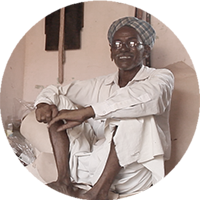
Decades later, we attempt to follow those footprints back to the shoemakers. This year's annual exhibition, 'Rohi," we invite you to listen to their stories of migration, struggle, relationships, and change.
What is Rohi?
For a Kachchi leather artisan, finding the perfect stone slab to work on is pivotal. He usually searches for it by a river bank or in the hills, choosing one which is smooth to the touch and strong to its core. The stone is called Rohi -- after the holy leather artisan, Sant Rohidas.
Before starting work, the artisan bows to his Rohi. It is sacred. It resists the sharp blade and relentless pounding, its form intact through seasons and calamities. It is a steady companion in all the moments leading to the artisan’s creation. Often, a father passes his Rohi down to his son as an heirloom.
Watch the Rohi documentary film trailer below


Words from the artisans
The Origins of the Meghwars
There was a drought / People were suffering / The Gods heeded the sacrifice / of Megh Rikh and let loose the rains. / Since then we became the Meghwars.
Haatar & Community Relations
"We made the shoes, and our clients rewarded us with what they felt was appropriate- grains, clothes, dairy or cattle. That is how the value for our work was quantified, never with money."
Tanning Process
"We made the shoes, and our clients rewarded us with what they felt was appropriate -- grains, clothes, ghee or cattle. "
Change
"If we get work in the factory, our salary will be enough to live comfortably. But when the wind blows towards us, it brings those bad fumes from the chimneys. Even the trees have become darker since the factory came up. For the pocket it is good, but for our health, it isn’t. But the bigger reason I cannot work there is because I cannot leave this leather work -- I am devoted to it."
Resilience
"Our skill and devotion to leather runs deep in my veins, but I have no attachment to the way my community was made to live in the old days. "
Meet the leather artisans who contributed their expertise to this exhibition

Meet the Rohi exhibition team
Curators
Paresh has a keen interest in the arts & craft sector, and has been an integral part of the Khamir team since its inception in 2005. He currently holds the position of Design Manager. He has led coordination of research and documentation of the leather artisan communities of Kachchh for Rohi.
Dipesh is a commerce graduate with extensive experience of working with artisan communities. With an interest in collecting stories of artisan lives, he has been a key mentor for the Rohi exhibition.
Srishti is a craft product designer and facilitator at Khamir. Her interest in craft cultures has led her to travel many parts of India to map and documenting handicraft stories. She has lived in Kachchh for 1.5 years, building on her specialization in hard goods. For Rohi, Srishti has led research on traditional leather products and techniques in Kachchh.
Having completed a specialization in Ceramics at IICD, clay is the prime material of Niraj's work. Learning from this beautiful and easily moldable material, he has always been open to all new explorations in other crafts and materials as well. He has been at Khamir for the past two years. His research focus for the Rohi exhibition has been on techniques of leather making and tanning.
As an AIF Clinton Fellow, Ambika consults Khamir on their brand and digital communications. She developed the Rohi exhibition brand, graphic materials, and website. Prior to moving to Bhuj, Ambika was a design strategist in Brooklyn, where she helped leading humanitarian organizations share their stories. She has long been drawn to the handicrafts of India, and loves exploring the artistic expressions of Kachchh.
Kasturi is a Mumbai-based filmmaker. She has been at Khamir for the last year, photographing the pastoral lifestyle of the Maldharis and archiving projects like recycled plastic weaving and blockprinting. For Rohi, she is creating a film on the leather artisans’ cultural evolution. Prior to moving to Bhuj, Kasturi worked for NABARD to film agricultural innovation across India. She is a passionate traveler, and is continually fascinated and inspired by rural India.
Jyothirmayee Bommana, a young interior designer based in Bangalore feels that, “creativity arises from an intent vision and a flowering heart.” For Rohi, she created an illustrative space that highlights the leather artisans' passion for their craft. Her love for nature constantly aspires her in expressing through poetry, sketching and performance art.


































